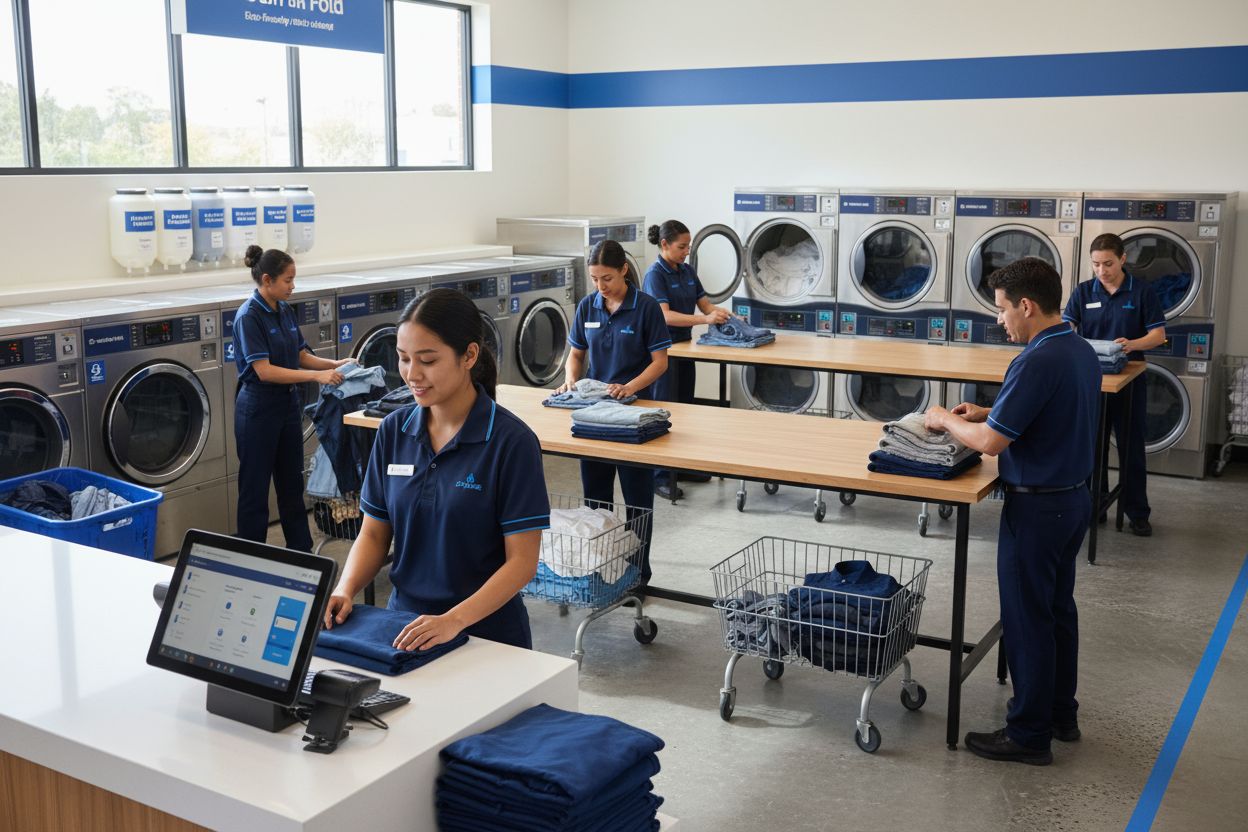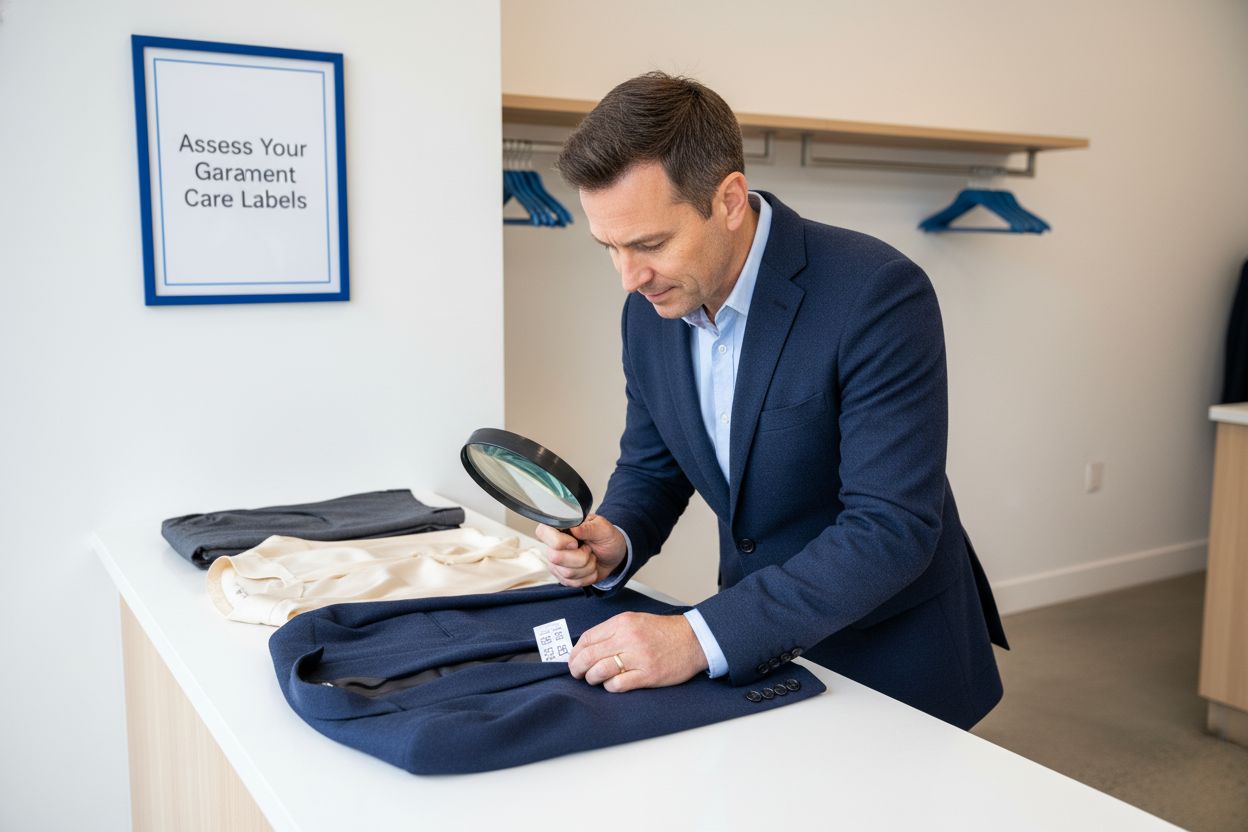Dry Cleaning: How Does It Work? A Clear, Step-by-Step Guide
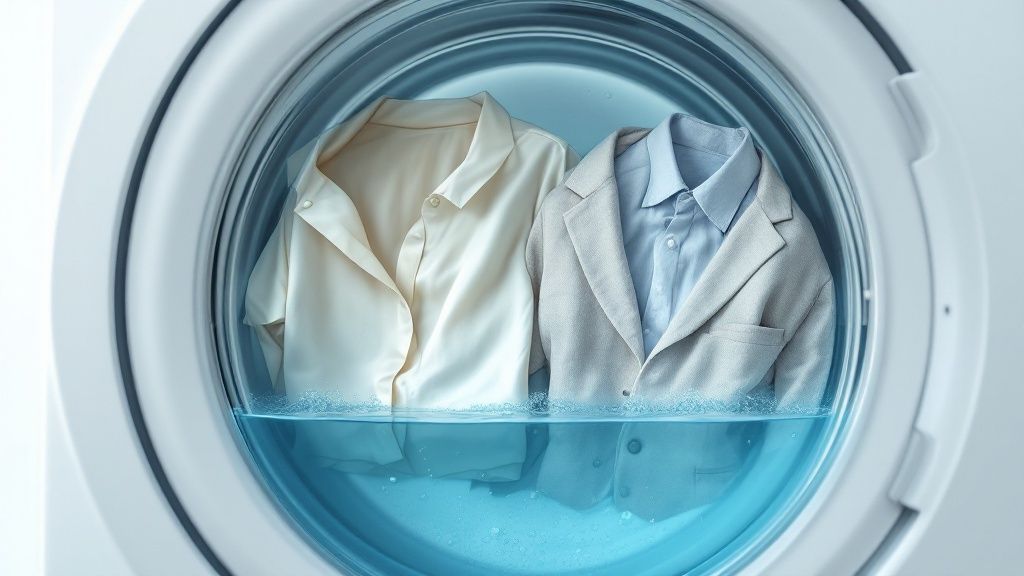
At its core, dry cleaning is a specialized cleaning method that uses chemical solvents instead of water to lift dirt and stains from delicate fabrics. This water-free approach is the secret sauce for preserving the shape, color, and texture of garments that a traditional washing machine would absolutely ruin.
What Happens When You Dry Clean Your Clothes
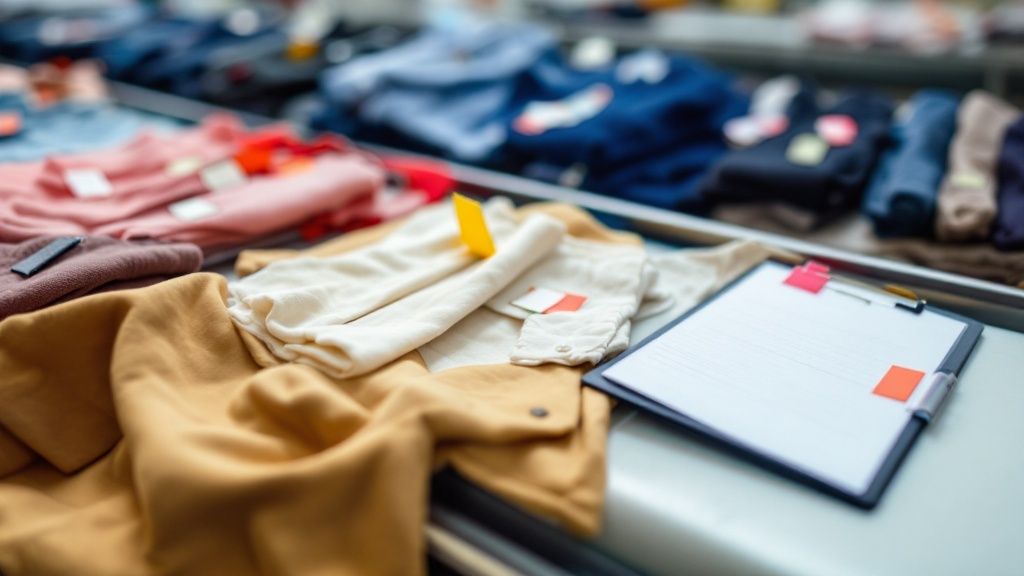
You drop off a delicate silk blouse or a structured wool blazer, and it comes back looking pristine. But what magic happens in between? To really get how dry cleaning works, you first need to understand just how different it is from doing laundry at home.
Think of it like this: water is a fantastic cleaner, but it can be a bit of a bully. It causes natural fibers like wool and silk to swell, shrink, or completely lose their shape. Your washing machine's combination of water, detergent, and aggressive tumbling is just too much for tailored suits, beaded gowns, or fine knitwear.
Now, despite its name, dry cleaning isn't a completely "dry" process. Your clothes do get wet, just not with water. Instead, they’re immersed in a liquid solvent that's powerful enough to dissolve stubborn oils and grease but gentle enough to leave delicate fibers unharmed.
Fun fact: The term "dry cleaning" dates back to the mid-1800s. A Frenchman named Jean-Baptiste Jolly accidentally spilled a kerosene lamp on a tablecloth and was shocked to see it came out cleaner. This happy accident sparked the first experiments with gasoline-based solvents.
This fundamental difference is what it’s all about. The entire process is built to attack oil-based stains (like salad dressing or body oils) that water often leaves behind, all while keeping the fabric’s integrity perfectly intact.
Dry Cleaning vs Home Washing At a Glance
To really see the contrast, let's put the two methods side-by-side. This quick overview makes it crystal clear why some garments come with that non-negotiable "Dry Clean Only" tag.
As you can see, each method has its place. For your durable, everyday clothes, a home wash is perfect. But for those special, structured, or sensitive items, dry cleaning is the only way to ensure they stay looking their best.
The Dry Cleaning Journey From Drop-Off to Pickup
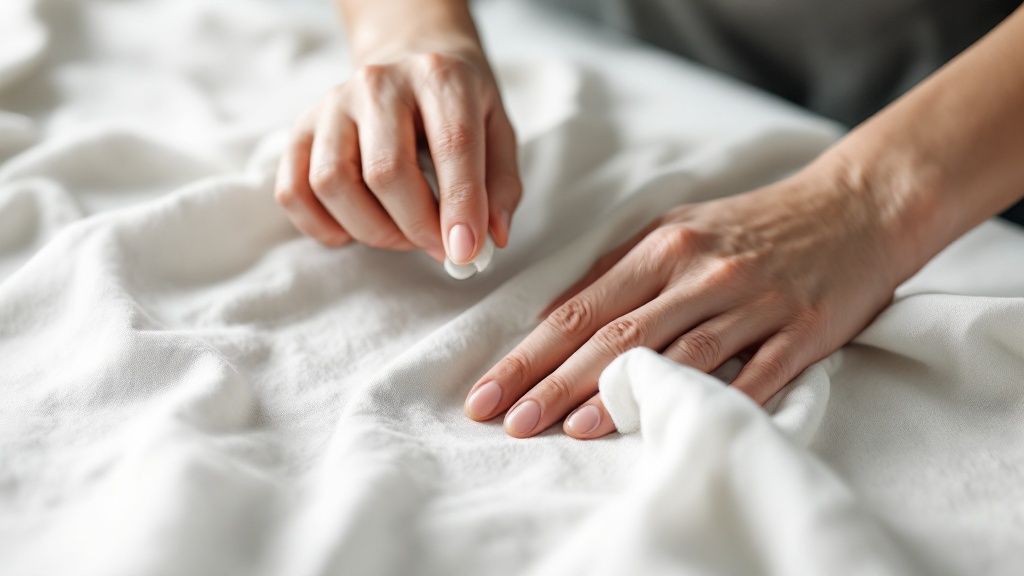
Ever wonder what really happens to your favorite blazer after you drop it off? Think of it as a spa day for your clothes. It’s a meticulous, hands-on process designed to pamper and restore your garments, making sure they come back to you looking absolutely immaculate.
This journey is a perfect example of how professional cleaning achieves results that your washing machine at home just can't touch. It all starts the moment you hand your clothes over the counter.
Step 1: Inspection and Tagging
First things first, every single garment gets a thorough once-over. A trained pro will examine each piece for things like loose buttons or fraying seams and take note of any specific stains you pointed out. This is also where they’ll check the care label to confirm the fabric type and any special handling instructions from the manufacturer.
To make sure your items never get mixed up with someone else's, each piece is tagged with its own unique ID number. This little tag is like a passport, following your garment through every single stage—from the cleaning machine to the final press—guaranteeing it finds its way back to you. For a full rundown of what to expect, check out the detailed breakdown of our service process.
Step 2: Pre-Treatment and Spotting
Before the main event, it’s time for some targeted therapy. This stage is called spotting, and it’s where the real artistry of dry cleaning comes into play. Stain specialists use a combination of professional-grade chemical agents and specialized tools on a "spotting board" to tackle stubborn blemishes one by one.
Different stains require different treatments. An oil-based stain from a salad dressing needs a completely different approach than a water-based one from a coffee spill. This specialized, manual pre-treatment is a key reason dry cleaning is so effective.
This careful, hands-on step dramatically boosts the chances of removing tough marks completely, all without harming the delicate fabric underneath.
Step 3: The Cleaning Cycle
Next up, your clothes are loaded into a large, sophisticated dry cleaning machine. It might look a bit like a front-loading washer, but it works on a completely different principle. Instead of water, the drum fills with a liquid cleaning solvent that gently tumbles with the clothes.
This solvent is fantastic at dissolving oils and grease, lifting dirt right out of the fibers. The machine then runs a rinse cycle using fresh, filtered solvent before moving into a gentle extraction phase. This spin cycle carefully removes most of the solvent, which is then distilled and recycled for future use in a closed-loop system. It's a process that’s both incredibly effective and environmentally mindful.
Step 4: Drying and Finishing
After the cleaning cycle, the garments are gently dried with warm air. The temperature is precisely controlled to protect the fabric and evaporate any last traces of solvent. When done right, your items should come out feeling soft and completely odorless.
But the journey isn't over yet. Once dry, each item heads to the finishing station for the final, crucial touches. This includes:
- Post-Spotting: A final check for any sneaky stains that might need a little more attention.
- Pressing and Steaming: Skilled technicians use specialized equipment to press and steam each garment, expertly restoring its original shape, crispness, and drape.
- Final Inspection: One last quality control check ensures everything is perfect—no stains, no damage, and a flawless press.
Finally, your garment is placed in a protective bag, ready and waiting for you to pick it up, looking as good as new.
Understanding the Solvents: The Science of Clean
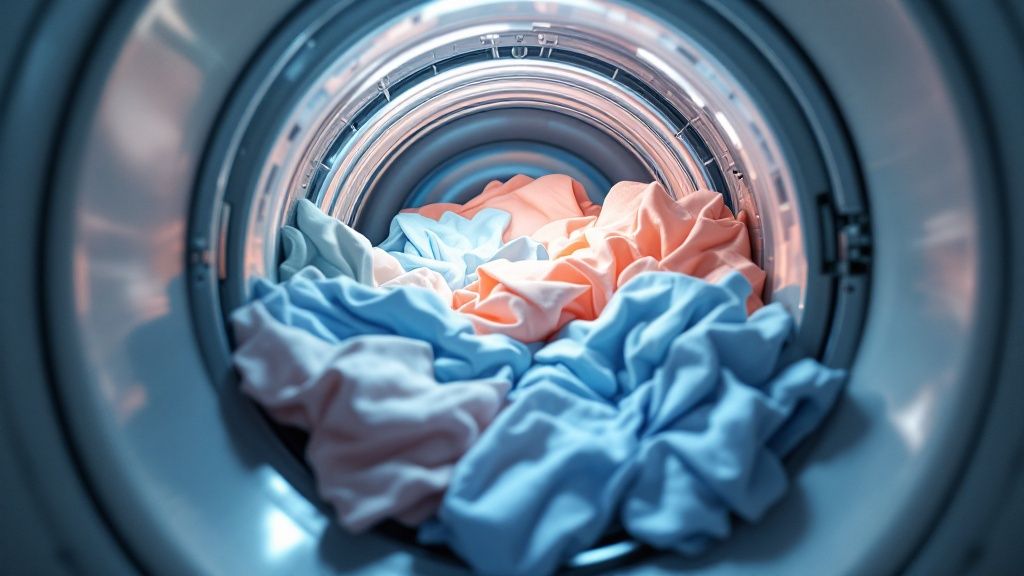
The real magic behind dry cleaning isn't the machine—it's the solvent. These specialized liquids are the key to lifting away dirt, grime, and especially oils without using water, which can damage delicate fabrics. Think of them as precision tools, each designed to dissolve specific types of stains while being gentle on fibers like silk, wool, and rayon.
For decades, one solvent absolutely dominated the industry: perchloroethylene, or PERC as it's more commonly known. It became the gold standard for a reason. It's incredibly effective, non-flammable, and works fast to dissolve grease and oil, leaving clothes with a uniquely crisp, clean finish that’s tough to match.
But its biggest strength also turned out to be its greatest weakness. Over the years, serious concerns cropped up about PERC's impact on the environment and our health. This has kicked off a massive shift in the industry, pushing cleaners toward safer, more sustainable alternatives.
The Shift to Greener Solvents
As people have become more eco-conscious, the demand for greener cleaning methods has exploded. This has opened the door for some really innovative solvents that get the job done without the heavy environmental baggage.
Even though "dry cleaning" sounds like a water-free process, it's always used a liquid chemical solvent. PERC was the old standby, but that's changing fast. Today, the industry is moving toward options like hydrocarbon solvents, liquid silicone, and even high-tech carbon dioxide (CO2) systems. This isn't a small trend. In the United States, PERC's market share has plummeted from over 90% in the early 2000s to less than 50% today. States like California are even phasing it out entirely. You can explore more data on the evolving dry cleaning market and its new technologies.
These newer options are what you'll typically find at cleaners advertising "green" or "organic" services.
What does "organic" dry cleaning mean?
This one can be tricky. In chemistry, "organic" just means a compound is carbon-based. By that definition, most dry cleaning solvents, including old-school PERC and modern hydrocarbons, are technically organic. But in marketing, the term is used to signal a process that’s more natural, less harsh, and better for the planet.
A Closer Look at Modern Alternatives
Today’s cleaners have a whole toolkit of solvents to choose from, each with its own pros and cons. Knowing a little about them helps you understand what you're really getting when you drop off your clothes.
- Hydrocarbon Solvents: This is a popular petroleum-based alternative to PERC. It’s much less aggressive, which makes it fantastic for delicate items with beads, sequins, or special trim. The cleaning cycle takes a bit longer, but the result is a garment that feels incredibly soft and has no chemical odor.
- Liquid Silicone (GreenEarth): You’ve probably heard of this one. Marketed as GreenEarth Cleaning, this eco-friendly option is derived from sand. The solvent itself, decamethylcyclopentasiloxane (or D5), is chemically inert. It's so safe that it's a common ingredient in everyday lotions and cosmetics. When it breaks down, it just reverts to sand, water, and carbon dioxide, leaving almost no environmental footprint.
- Liquid CO2 Cleaning: This is one of the most advanced methods out there. It uses carbon dioxide that’s been captured as a byproduct from other industrial processes. Under extremely high pressure, the CO2 turns into a liquid that acts as a powerful-yet-gentle cleaning agent. It cleans at low temperatures, is completely non-toxic, and after the cycle finishes, the CO2 is converted back to a gas and recycled for the next load.
The choice of solvent isn't just some technical detail—it directly affects the lifespan of your clothes and the health of our planet. When you opt for a cleaner using modern, eco-friendly solvents, you’re not just getting a great clean. You're preserving your wardrobe and supporting a healthier, more sustainable industry.
Decoding Care Labels: Which Garments Need a Pro?

That tiny tag stitched into your favorite sweater holds the secret to its longevity. But let's be honest—those cryptic symbols and phrases like "Professionally Dry Clean" can feel like a foreign language. Cracking this code is the first step in protecting your wardrobe investment and preventing a laundry disaster.
The most straightforward instruction you'll ever see is "Dry Clean Only." Think of this as a non-negotiable directive straight from the manufacturer. It means the garment's fabric, dye, or construction simply isn't built to survive a water-based wash. Ignoring this label is a gamble you’ll almost certainly lose.
Why Some Fabrics Fear Water
At its core, the need for dry cleaning comes down to avoiding the structural damage that water can inflict. Certain fibers swell up and distort when they get soaked, leading to irreversible changes in their size, shape, and feel. This is especially true for delicate, natural materials.
Imagine a tailored wool blazer. Its sharp lines and structured shoulders are the result of a careful combination of fabric and internal construction. A trip through a washing machine would cause those wool fibers to felt and shrink, turning your sharp suit jacket into a lumpy, misshapen mess. The same goes for silk—water can strip it of its signature luster and cause its vibrant colors to bleed.
Here are some of the most common materials that really thrive with professional care:
- Silk: Prone to losing its sheen and texture in water.
- Wool: Can shrink, felt, and lose its structured shape, especially in tailored items.
- Velvet: Water has a nasty habit of crushing the delicate pile, leaving permanent marks.
- Rayon: Notorious for shrinking significantly when it gets wet.
- Leather and Suede: These require specialized cleaning processes that water would completely ruin.
The decision to dry clean isn't just about getting out a tough stain; it's about preservation. Professional cleaning maintains a garment's original drape, feel, and fit, which is absolutely crucial for high-quality and structured pieces.
While many fabrics need this kind of professional attention, that doesn't mean every delicate item is off-limits for home care. Though some pieces genuinely require a pro's touch, you might be surprised to learn there are often ways to safely wash 'dry clean only' clothes at home.
Understanding Special Instructions
Looking beyond the basics, you might spot labels that say "Professionally Dry Clean" or show specific symbols like a "P" or "F" inside a circle. These are actually notes for the cleaner, telling them which type of solvent is safest for that particular garment.
This is where understanding a bit about the dry cleaning process becomes practical. It shows that a professional cleaner has a whole toolkit of methods they can use to match the specific needs of your clothes.
Similarly, advanced textiles, like the ones in high-performance athletic wear, often benefit from specialized care. For anyone interested in keeping these unique items in top shape, you can find more tips in our guide to caring for high-performance fabrics.
By paying attention to these labels, you're not just following rules—you're actively extending the life and beauty of your most cherished garments.
The Evolution of Dry Cleaning Technology
You might think of dry cleaning as a bit old-fashioned, but the industry has been through some massive, quiet revolutions behind the scenes. We're long past the days of pure guesswork and manual labor. Today’s best dry cleaners are high-tech, precise, and have a serious focus on both customer convenience and environmental impact.
Think about the early dry cleaning machines. They were clunky, inefficient, and frankly, a bit hazardous. A cleaner had to physically move wet, solvent-drenched clothes from a washer to a separate dryer. Not only was this a huge hassle, but it also exposed workers and the environment to a constant stream of chemical vapors. Thankfully, modern machines have completely changed the game.
Professional dry cleaning follows industry standards set by the Dry Cleaning and Laundry Institute International to ensure proper care for delicate fabrics that can’t be water-washed.
From Manual Labor to Smart Machines
Step into a modern dry cleaning facility, and you'll find machines that are true marvels of engineering. Most are what we call closed-loop systems, which means the entire process—washing, rinsing, and drying—happens inside a single, sealed chamber. This is a huge leap forward for a few key reasons:
- Precision Control: These aren't just dumb tumblers. Computer-controlled cycles manage every little detail, from the exact temperature of the solvent to the specific drying time, ensuring every type of fabric gets the perfect treatment.
- Solvent Recycling: One of the smartest features is their ability to recover and distill nearly all the solvent used in a cycle. This dramatically cuts down on chemical waste and makes the whole operation more cost-effective.
- Enhanced Safety: Because the entire process is contained, worker exposure to chemicals is minimized, and those vapors are prevented from escaping into the atmosphere.
This shift to automated, intelligent machinery means your clothes get a more tailored and reliable cleaning every single time. It’s less about brute force and more about scientific precision. The result? Superior cleaning that actually protects your favorite garments.
The Digital Transformation of Service
But the tech upgrades aren't just happening inside the machines; they've also completely reshaped the customer experience. The industry has finally caught up to the digital age, using tools that make professional garment care more accessible than ever. You can now use a mobile app to schedule a pickup on your way home from work, track your order’s progress in real-time, and pay without ever pulling out your wallet.
The global dry-cleaning and laundry services market hit around $83.2 billion in 2025 and is expected to climb to $149.1 billion by 2035. A big driver of this growth is technology, from AI-powered scheduling to the digital platforms that give customers the convenience they expect. You can learn more about these innovative market trends.
This digital layer makes getting your clothes cleaned feel less like a chore and more like the seamless, on-demand service we've all gotten used to.
A Greener, More Sustainable Future
Perhaps the most important evolution, though, has been the industry's growing commitment to sustainability. Pushed by both environmental regulations and customers who care, cleaners are actively investing in greener technologies. This goes beyond just the eco-friendly solvents we talked about earlier. It also means installing energy-efficient equipment that uses less electricity and water.
This focus proves that a modern industry can care about quality, convenience, and its environmental footprint. High-tech cleaning can—and should be—responsible cleaning.
Common Dry Cleaning Questions Answered
Even with a solid understanding of the process, a few questions always pop up. The world of dry cleaning is full of its own myths and curiosities, so let’s clear the air and tackle some of the most common ones.
Getting these answers straight helps you make smarter choices for your wardrobe and ensures you get the best possible results every single time you drop off your clothes.
Can Dry Cleaning Remove Every Type of Stain?
While dry cleaning is incredibly powerful, it isn’t a magic wand for every single spot. Its true superpower is tackling oil-based and grease stains. Think salad dressing, makeup, or body oils—the solvents are specifically designed to dissolve these culprits with amazing efficiency.
Water-based stains, however, are a different beast. Things like coffee, wine, or sweat often need a specialized pre-treatment, a process we call "spotting," before the main cleaning cycle even starts. Whether it comes out depends on the stain's age, the fabric, and what caused it in the first place. That’s why our guide on how dry cleaners remove stubborn stains can be so helpful. Always be sure to point out any specific stains to your cleaner so they can give them the attention they need.
Is Eco-Friendly Dry Cleaning Really Better?
Absolutely. "Eco-friendly" isn't just some marketing buzzword; it's a huge leap forward in both safety and sustainability. For years, the industry standard was PERC, a solvent that has been linked to health risks and environmental damage.
The newer, greener alternatives are a complete game-changer:
- Liquid Silicone (GreenEarth): This popular option is actually derived from sand and safely biodegrades back into natural elements.
- Hydrocarbon Solvents: Though petroleum-based, these are far gentler and much less toxic than PERC ever was.
- Liquid CO2: This high-tech method uses captured carbon dioxide, so it leaves zero chemical residue behind.
When you choose an eco-friendly cleaner, you’re supporting a process that’s safer for the planet, the people handling your clothes, and your garments themselves.
Why Do My Clothes Sometimes Smell After Cleaning?
Ideally, your clothes should come back from the cleaner with no scent at all. If you catch a faint chemical odor, it usually means the solvent wasn't completely removed during the drying cycle. This is something a reputable cleaner with well-maintained, modern equipment can easily prevent.
A strong, lingering chemical smell is a major red flag. It points to a rushed or incomplete process. Airing the garment out might help a little, but you should definitely let your cleaner know if the odor sticks around. Properly cleaned clothes should be completely odorless.
Can I Dry Clean an Item Labeled "Hand Wash Only"?
In many cases, the answer is yes. Clothing manufacturers sometimes use "Hand Wash Only" as a catch-all safety warning for extremely delicate items like fine knits or silks. Ironically, professional dry cleaning can often be a safer and gentler option than dunking it in a sink at home.
The reason is simple: dry cleaning skips the water agitation, potential stretching, and color bleeding that can happen even when you’re being careful. Your best bet is to always talk to your professional cleaner. They can inspect the garment’s fabric and construction to figure out the safest, most effective cleaning method. For those managing all parts of their wardrobe, going beyond just professional services and mastering the art of general laundry strategies can be a huge help.
At Columbia Pike Laundry, we believe that understanding the process gives you peace of mind. Let us handle the complexities so you can enjoy perfectly cared-for clothes without the hassle. Reclaim your weekend and schedule your first pickup today! Visit us at https://columbiapikelaundry.com to get started.
Popular Blog Articles

Meet the Author
Daniel Logan didn’t start CPL because he loved laundry. He started it because his family was drowning in time debt, and laundry was one of the biggest weights.
Mornings were chaos with two kids under 5. Evenings felt like catch-up. And weekends? Gone to sorting socks and folding piles.
He knew his story wasn’t unique. So he built a business that gave families like his just a little bit of breathing room one load at a time.
With no laundry experience but deep tech skills, Daniel rolled up his sleeves, doing every job himself while building systems that turned it into a modern laundry service that saves customers time, simplifies their lives, and delivers reliability they can count on.
That’s where CPL began. Not from a playbook, but from pain. From one dad trying to buy back time: for himself, and for every household like his.

